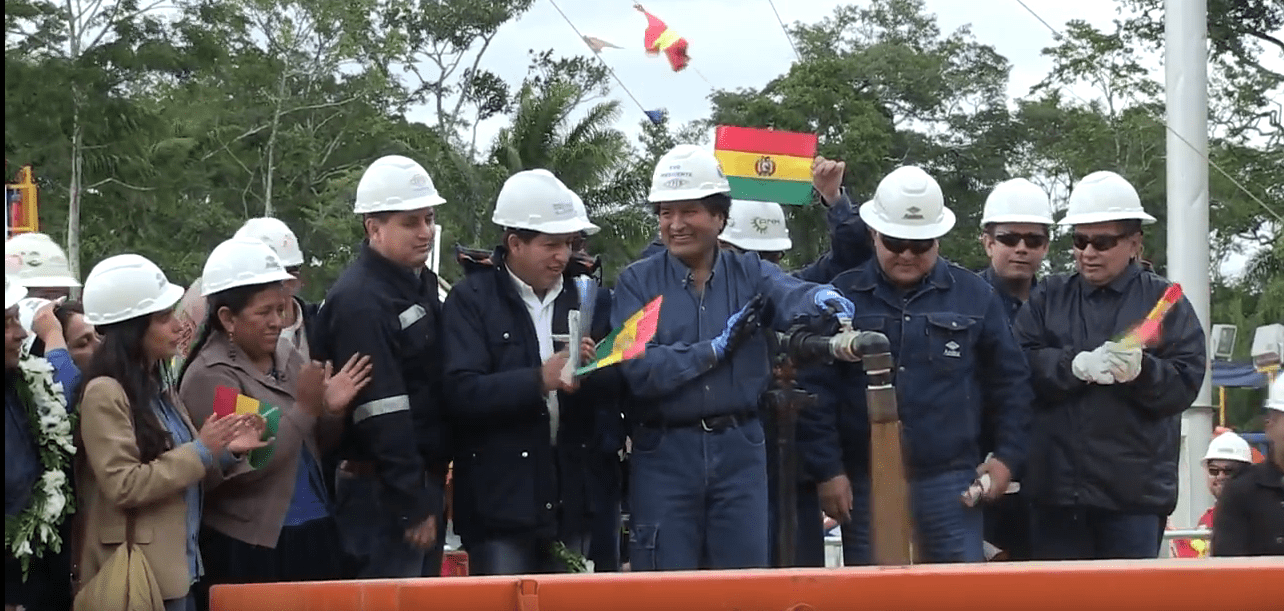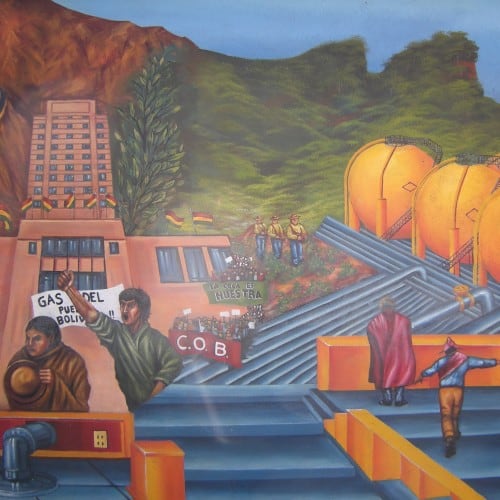During the May 2015 announcement for Bolivia’s new cross-country Incahuasi–Cochabamba Gas Pipeline, a high official in Bolivia’s state-run gas company looked beyond the three-year, half-billion-dollar project to the future ahead. The company proposed a future connection to Peru’s fuel transport network in the southeast of the latter country. “With that,” said Cristian Inchauste, general manager of YPFB Transporte SA, “We would arrive at the Pacific, the great beauty is to arrive at the Pacific. Con eso llegaríamos al Pacífico, la gran belleza es llegar al Pacífico.”
Welcome to the strange, emotion-laden world where Bolivian nationalism and infrastructure planning overlap. In this executive speech, “we” is understood to mean all Bolivians. Literally, that arrival will be squeezed within a twenty-four-inch diameter metal tube. Metaphorically, the arrival comes through exporting a major product, transported by a nationalized company, to the Pacific Ocean and beyond. And the Pacific, well that is the stuff dreams are made of.
The nineteenth-century loss of Pacific coastal territory to Chile constitutes the greatest wound to Bolivia’s national pride, a wound that continues to be deeply felt.
During one of my first stays in the country, I joined in the celebration of Aymara New Year at dawn on the June 21 solstice. I spent the morning on “the rim,” the edge of the high plateau overlooking the capital city of La Paz. Residents of El Alto had gathered overnight for the Aymara New Year festivities, awaiting the sunrise in the chilled high-altitude air. Libations and dancing kept them warm. Now in the almost-too-bright early morning sun, Andrés and Angel—clearly friends—chat with me, the foreigner.
“Where are you from?,” they ask. I have them guess. Once he knows I am not, Angel volunteers, “If you were from Chile, I would fight you.” His taller and more imposing friend Andrés is quick to dispel the threat, “If you would fight someone from Chile, you would lose.” “No! Why?” “They eat meat and you eat chuño.” Chuño is a dark, flavorful food made by repeatedly freeze-drying potatoes in the Andean cold, but eating meat from cattle is a ready marker of economic success and is presumed to provide greater strength. The contrast between meat and freeze-dried potatoes sums up the economic gap between Bolivia—long South America’s poorest country—and its wealthy neighbor.

On the Bolivian side, that gulf feels more like a theft. Chilean troops occupied the coastal region of Antofagasta in 1879, during the War of the Pacific. Unlike the country’s other territorial losses—to Peru, to Brazil, to Paraguay—this one left the country landlocked. For reasons of economics and national dignity, it stings differently. Bolivia has nursed and nurtured this sense of injury in public ever since.
How and why did people come to understand the loss of territory as a kind of wound?
In studying Thai nationalism, Thongchai Winichakul (1994; 1996) proposed the notion of a geo-body: the imaginative, practical, and emotional way in which a mapped territory is made into the object of nationhood. Like a biological body, the demarcated territory has integrity and is vulnerable to painful dismemberment. Losses on a map are felt as though something personal was ripped apart, held captive. This construct, Winichakul (1996, 88) writes, transformed the defeats of Siam royal government into “the agony of losing Siamese territory, the victimization of Siam.” Transposing this concept to China during the period of Western imperialism, William Callahan (2009, 141) explores “the continual self-crafting of any nation’s image,” as told through maps that celebrate sovereignty but “also mourn the loss of national territories through a cartography of national humiliation.”
Bolivia’s national story is told in a similar register of enduring and overcoming humiliations. The national anthem concludes with a thrice-sung vow “to die before living as slaves.”
The captured province of Litoral was given representation in the national parliament for two decades after it fell. Since 1963, foreign diplomats entering the Ministry of Foreign Affairs have walked past the massive mural Hacia el Mar (or Alegoría al Mar Boliviano)by Miguel Alandia Pantoja in La Paz. In it, a figure representing the Bolivian nation stretches his body from the Andes over the coast plain, stretching out an arm over the Pacific Ocean. Every year, Bolivia’s tiny Navy (it patrols Lake Titicaca and other territorial waters) files through the capital in dress uniform, marking the Day of the Sea. Just this year, the Navy’s Ensign has joined other Bolivian flags to fly over government buildings in La Paz.
No issue unites the Bolivian political spectrum like the demand for the return of maritime access. The recent Bolivian novel Palacio Quemado (Paz Soldán 2006) centers on a unscrupulous political speechwriter, ready to serve any client, to shift with the political winds to embrace any policy, but never to renounce the right to the sea. Five ex-presidents comprise the country’s advisory committee to the General Directorate on the Maritime Demand. This year, the country’s diplomatic campaign for Chile to negotiate Bolivian sovereignty over some portion of the coast reached the International Court of Justice in The Hague. In defiance of history and the only borders any living Bolivian has ever known, all these practices keep the enlarged geo-body of the country, the one that reaches the sea, alive.
So it is no surprise that a general manager at the national oil company, too, dreams of reaching the Pacific. Or that the past president of YPFB, Carlos Villegas Quiroga, who presided over the 2006 nationalization of the country’s gas industry, held out connecting the company’s network to the sea as a “great longing.” In the globalizing world of recent decades, the lack of a port has merged with the country’s other economic wounds. Not having the sea came to be seen as another reason why some Bolivians—especially its poorest residents from the Altiplano—eat so much chuño and not enough meat.

But there is another vision of the relation between gas export and the nation. If Bolivia’s great territorial wound is the loss of the Pacific, its great economic wound is its continual role as provider of its precious resources to others. Left nationalisms in Bolivia have long mourned the loss of its wealth, extracted laboriously but leaving little trace of wealth or industry. Summing up a generation of leftist economic critique, Eduardo Galeano (1973, 237) lamented that “The region has been condemned to sell primary products to keep foreign factories humming.” Galeano’s polemical Open Veins of Latin America, used the Cerro Rico silver mines in colonial Potosí and the foreign-owned tin mines of the Bolivia’s southwest as touchstones of extracted wealth coupled with local poverty.
In 2003, El Alto—a city of migrants that is the symbolic capital of the indigenous (mostly Aymara) Altiplano—did get a chance to fight, to fight that poverty and, in a way, to fight Chile. The city was at the forefront of a nationwide revolt against a government proposal to export gas resources to Chile. (This “Gas War” is part of a series of events I chart in my fieldwork on recent protest in Bolivia; see Bjork-James (2013).) The grassroots campaign proclaimed, “The gas is ours.” Residents organized weeks of road blockades, isolating the capital La Paz from the rest of the country. Dozens of Alteños were killed in government attempts to break the blockade, most of them dying on a single weekend in October 2003.
Ironically middle-class residents of La Paz, who get their food from supermarkets, ran out of food before poor Alteños, who buy their chuño in fifty-kilo sacks for slow and steady use. Matching their chuño-powered bodies and an innovative set of tactics against government soldiers with guns, they prevailed.
The government of Evo Morales, and the national gas corporation YPFB, which expanded after Morales’ partial nationalization of gas resources in 2006, are the product of the Gas War. Government policies are still described with reference to the “October Agenda” that emerged from the 2003 conflict, a list topped by resource nationalization, a new plurinational Constitution, and greater indigenous autonomy. Morales has pledged to “close the open veins of Latin America for the good of our peoples.”
And so, there is something deeply disconcerting about narrating a gas export pipeline as a national dream or a great beauty.
Leaving aside the circumstances and consequences of gas exploration, drilling, and extraction for the moment, the grassroots campaigners who fought in the gas war saw keeping gas in the country as part of the fight against poverty. They envisioned it being used for domestic industrialization, restoring high-paying jobs and economic strength within the country. These ideas continue to circulate in current social movements. I learned not to be surprised when an unemployed worker or a teacher at a union picket spoke to me of “the reactivation of the productive apparatus.”
The new proposal to propel gas out of the country, so as to export it overseas from southern Peru, has some differences from the 2003 proposal. It would be pumped through the pipeline by a public gas corporation, YPFB Transportes SA, and pumped to Peru not Chile. On either end, however, that Bolivian gas will be in foreign hands. Partial nationalization means that the gas resources of the country formally belong to the state, but the foreign corporations invested in the sector have seen little change on the ground. Under the new rules France-based Total, which will supply the pipeline with gas from the Incahuasi field, only keeps half of the proceeds, paying the other half to the Bolivian state (32% as tax, 18% as royalty).
Many of the objections from 2003 still apply, though: much of the wealth generated by this new megaproject will be enjoyed far from Bolivia, whether by Total’s shareholders or through industrial ventures fueled by the exported gas. The nationalist dream of the Pacific, and the idea of healing Bolivia’s geo-body through a gas pipeline that reaches that ocean, papers over these concerns. “Forgetting… is a crucial factor” in nationalism, wrote Ernest Renan (2013), one of the first theorists of the subject.
Gas executives aside, “arriving at the sea” will be a very distant metaphor from the realities of this new infrastructural endeavor.
Works Cited
Bjork-James, Carwil. 2013. “Claiming Space, Redefining Politics: Urban Protest and Grassroots Power in Bolivia.” PhD dissertation. New York: City University of New York.
Callahan, William A. 2009. “The Cartography of National Humiliation and the Emergence of China’s Geobody.” Public Culture 21 (1): 141–73.
Galeano, Eduardo. 1973. Open Veins of Latin America: Five Centuries of the Pillage of a Continent. New York: Monthly Review Press.
Paz Soldán, Edmundo. 2006. Palacio Quemado. Miami: Alfaguara.
Renan, Ernest. 2013. “What Is a Nation?” In \iNation and Narration, edited by Homi K. Bhabha, translated by Martin Thom, 8–22. New York: Routledge. Originally a lecture delivered at the Sorbonne, 11 March 1882. ‘Qu’est-ce qu’une nation?’, Oeuvres Completes (Paris, 1947-61), vol. I, pp. 887-907.
Thongchai Winichakul. 1994. Siam Mapped: A History of the Geo-Body of a Nation. Honolulu: University of Hawaii Press.
Winichakul, Thongchai. 1996. “Maps and the Formation of the Geo-Body of Siam.” In Asian Forms of the Nation, 67–92. New York: Routledge.




